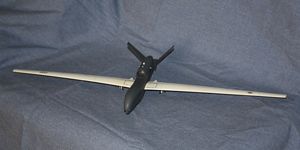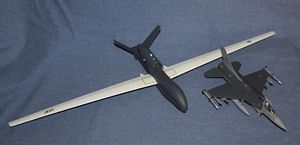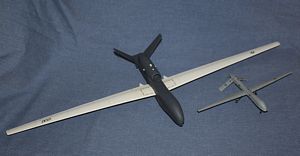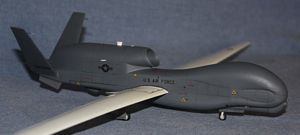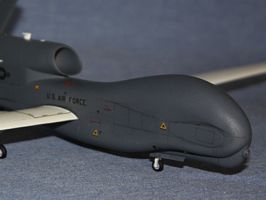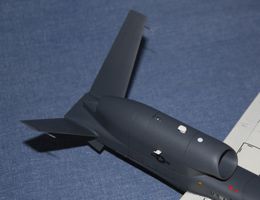Northrop Grumman RQ-4B Global Hawk
I like to build models of the planes that I have flown, so when I found out someone was going to make a model of the Global Hawk, I was quite happy. I was even more delighted when I saw that the model was going to be fairly accurate and pretty good quailty. So, I scooped one up and went right to work building it. I am fortunate that I have the ultimate reference at my finger tips (litterally) so I can say that this model is pretty darn close. Colse enough that I didn't feel like I needed to tweak anything.
The plane itself is actually very big. The wingspan is what really amazes most people. When you see pictures online, it looses a lot because of the angle the picture is taken from. The Global Hawk is larger than many manned fighters, and dwarfs smaller planes like the Predator.
The Global Hawk is actually a descendant from a long line of UAVs from Teledyne Ryan, who was aquired by Northrop Grumman. Actually, there are several versions of the Global Hawk out there right now. The Air Force has three versions, the Navy has one flying and one in development, the Germans have a version, and even NASA has two versions (although only flies one right now). I fly the Air Force Global Hawks and the NASA Global Hawk. (Look on the right.)
The plane can fly for over 24 hours, and up to 60,000 ft. I always think it's pretty cool that I am controlling a plane that is so hi up, and so far away, while I am sitting still on the ground. It's really strange when I'm flying over the Atlantic and controlling it from Edwards AFB.
Building the Hawk
The model itself was a prety good model. There were a few fit issues around the tail, which surprised me. The rest of the model went together really well, but I had to fill a few gaps around the V-tails, whish was difficult because of the small area I had to sand in. Other than that, it went together pretty well. The large seam across the radome on the nose of the plane was a pain to clean up though. They should have made the radome a seperate part that follows the lines of the plane to hide the seam, but that would have added another part. It would have made a better model though.
The model I got was from Italeri, which repackaged the model originally from Platz. The Italeri model had markings for three different planes, but don't use the Block 40 decals. The Block 40 actually has a different radome on the bottom, and looks quite a bit different. On a similar note, if you get the Platz model, don't use the NASA decals. The NASA planes are the ACTD planes and are very similar to the Block 10, or RQ-4A, Global Hawk, so they look different as well. One last note, the Edwards AFB planes don't have the ED letters on the tails and no colors on the tops of the tails. Just the tail number. I picked 042015, which is a Block 20 plane that we use for flight test.
For painting, I went with the paint scheme you probably see on most Global Hawks: Gunship Grey overall with white on top of the wings. Pretty simple, but paiting white is always a challange for me. It's easy to put on too much to make it show, so I have to take my time. It turned out pretty well, and I'm happy with it sitting next to other modern planes like the F-22 and the MQ-1B Predator.

